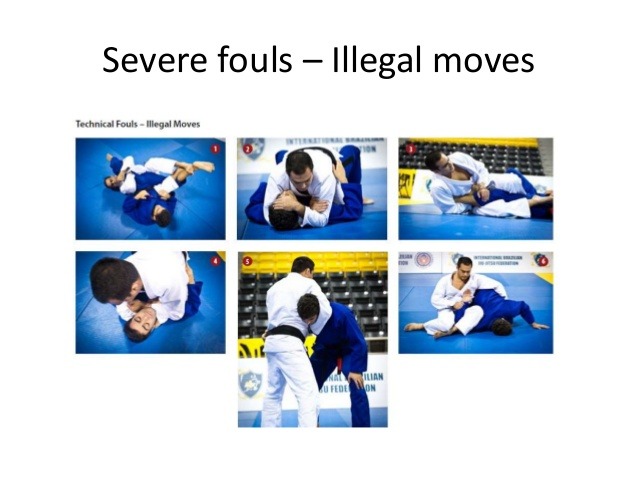
The issue of illegal BJJ moves is a pretty divisive one in the Jiu-Jitsu community. More advanced people hate the fact that there are restrictions on what they can do. Still, others are afraid of the possible consequences of creatin moves, and therefore, enjoy the fact they are safe from them. Both sides have merit in their approach. That’s why we have rules in competition and certain moves are not allowed at certain levels. Moreover, certain moves are simply not allowed, period. However, how do you approach training? Are illegal BJJ Moves still illegal to practice if you decide to?
I’m not a really big fan of the whole concept of Illegal BJJ moves. Particularly when I think the system is flawed. But let’s debate that a bit later. IN terms of training these types of moves, there are different points of view. Some people think everyone should be able to train everything, as long as there’s mutual consent, of course. Others think that there should be limitations according to the belt level to what people can do to others in training. Finally, some think rules should be followed the same in training and competition. Who has it right?
What Are Illegal Techniques?

When it comes to adults though, there are certain question marks. For one, I personally think that the belt restrictions are on point. There are certain moves that white or blue belts are just not ready for. However, I do think the purple belt is advanced enough to get a bit more slack. So far, muscle slicing attacks like the calf and biceps slicer, along with kneebars and toe holds are only allowed for brown and black belts.
Finally, there are the “truly” illegal BJJ moves that are outlawed from, anyone and everyone. At least under IBJJF/ UAEJJF rules. Those are heel hooks, neck cranks, and a bunch of other stuff, some meaningful and some not. And it would all be a lot easier to digest and accept if there weren’t different rules to offer a different option.
Who Decides What Is legal?
That’s easy. The people that organize the tournaments decide the rules. At a local level, this might be anything, from a club tournament to a state tournament. However, the biggest tournaments in the world, outside of professional events, are under the rules of the IBJJF / UAEJJF. There’s also ADCC, but that’s a whole different story, and not many people will get the chance to compete there anyway.
To that extent, the rulebooks of these organizations are subject to change, however minimal. Usually, that change is in the direction of adding more forbidden things, rather than making illegal BJJ moves legally. All of that is in order to ensure the maximum safety of the competitors, which is the right thing to do. However, the fact that you get to widen your arsenal as you progress through the ranks, means that you might be short-handed when it comes to suing stuff you weren’t allowed to use before.
How Does it All Work?
When you reach a creatin level, for example, a blue belt, suddenly you have different options at your disposal. So if you had your last tournament as a white belt a couple of weeks ago, now you have to think about different stuff, like jump guard and wristlocks. When it comes to purple belt, you do not really get anything new in terms of illegal BJJ moves.
The real issue usually arises at the brown belt level. This is when leg locks (apart from the straight ankle lock) come into play. In the past, this wasn’t much of a problem, but with everyone using them nowadays, there’s a lot of catching up to do. The same holds true for muscle slicing submissions, like the biceps slicer. Once again, you don’t really get too many new options when you reach the black belt.
Should You Do Illegal BJJ Moves In Training?
This brings us to the topic I wanted to touch on today. How do you go about training Illegal BJJ moves? Let’s leave heel hooks, neck cranks, and knee reaping to the side for a while. Those are all moves that remain illegal for all belt levels. Instead, let’s focus on the stuff that opens up as you reach the next belt level.

The answer is as early as possible. The decision here is down to instructors and not students. One of the best pieces of advice I got was a blue belt was to invest in leg locks early. That really pays dividends now that I’m a brown belt and didn’t have to start learning lower body submissions after the promotion. That got me thinking about rearranging the curriculum at our academy and exposing people to all the BJJ moves in training, where everything can be done in a safe and controlled environment. So, yes, I do think we should be training Illegal BJJ moves, from the earliest time possible.
In fact, I believe that individual restrictions work way better than belt or experience-related ones. When someone is rad,y just like with a promotion, they’ll get the right to start training creating things. For now, it seems to work as an experiment for my gym.
Wrapping Up
In cases where competitors of different belt levels end up in one category due to an insufficient number of competitors, the rules of the higher belt apply. That means a purple belt can go for everything a brown can in competition against a brown belt. To say the least, this should be the approach we have to train illegal BJJ moves in the gym. There are plenty of other ways of training, but one thing is for creatin – we shouldn’t handicap students by keeping them away from techniques that they’ll one day have to use in competition.











































